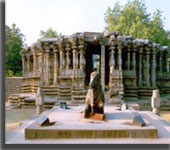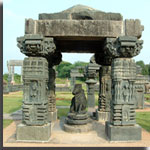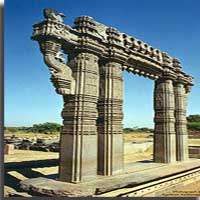History :
Kakatiya Dynasty is the south Indian Dynasty which ruled in Andhra Pradesh in India from 1083 CE to 1323 CE. The 12th and 13th centuries saw the emergence of the Kakatiyas and they were the first feudatories of the Western Chalukyas of Kalyana, ruling over a small territory near Warangal. The rule of Kakatiya Dynasty is considered as the most promising period of History of Telugu & Andhra Pradesh.
The next ruler Prola II ruled from AD 1110 TO 1158 as he expanded the dynasty to south and declared his independence.
His next successor was Rudra who ruled during AD 1158 to 1195. Rudra was a very much renowned ruler in Kakatiya Dynasty. As he stretched his empire till the north as far as till the Godavari Delta. To serve as a second capital, he constructed the fort at Warangal. He also faced the invasions of Yadavas of Devagiri.
The next king who ascended the throne was Mahadeva who extended the throne till Coastal Areas.
Ganapati was another king who came after Mahadeva who has made extension to Coastal regions. Ganapati was the supreme king among all the rulers of Kakatiya dynasty. As he played a pioneering role in consolidation of Telugu region under one rule. It was due to Ganapati's capability and courage that there was the establishment of a huge kingdom. He also promoted the trade practices in the kingdom.

Then the grand successor of Rudramba was Prataparuda. He came to power in AD 1295 TILL AD 1323. During this time the dynasty saw the extension of border till Raichur. With his initiatives some administrative reforms were introduced. He divided his army into seventy five 'Nayakships'. Later the Rayas of Vijayanagara took over the Nayakships and made growth in great extent. During this period only the Muslims invaded the empire of Kakatiya Dynasty in Andhra Pradesh for the first time.
Place |
Andhra Pradesh |
Period |
1100-1474 AD |
Language |
Telugu |
Religion |
Hindu |
Art and literature of Kakatiya dynasty

During AD 1162, the Thousand-Pillared Temple at Hanamkonda was built by the Kakatiya Dynasty. King Rudramba built this in is similar style and workmanship to the Ramappa temple. This temple is dedicated to Siva, Vishnu and Surya, and is star-shaped. The Nandi pavilion is also famous in which a huge granite bull still stands, which has the beautiful entrances to the shrine with pierced slabs used for screens and windows and an elegant open work by which the bracket-shafts are attached to the pillars are the other most interesting features of this temple.

An interesting feature of Warangal fort temple is there are four gateways called 'Kirti Stambhas' which face the four cardinal points of the compass.
The design of the gateways is redolent like the 'toranas' of the Great Stupa at Sanchi. The architecture and sculpture of these temples are magnificent as no one can fail to see the rich imagination, patient industry and skilful workmanship of the builders of the temples of the Kakatiya period.


